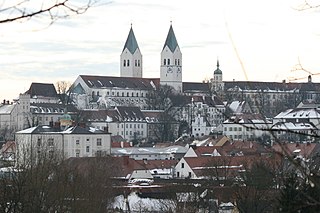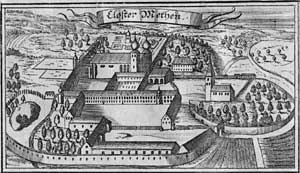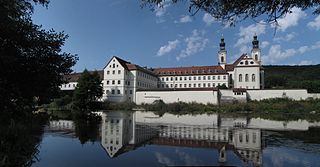
Freising is a university town in Bavaria, Germany, and the capital of the Freising Landkreis (district), with a population of about 50,000.

Eurasburg is a municipality in Oberbayern. It is situated about 40 kilometres south of the Bavarian state capital, Munich, in the county of Bad Tölz-Wolfratshausen.

Metten Abbey, or St. Michael's Abbey at Metten is a house of the Benedictine Order in Metten near Deggendorf, situated between the fringes of the Bavarian Forest and the valley of the Danube, in Bavaria in Germany.

Ilmmünster Abbey was a collegiate foundation (Kollegiatstift) of canons, formerly a Benedictine monastery, in Ilmmünster, Bavaria, Germany. The church continues in use as a parish church.

Tegernsee Abbey is a former Benedictine monastery in the town and district of Tegernsee in Bavaria. Both the abbey and the town that grew up around it are named after the Tegernsee, the lake on the shores of which they are located. The name is from the Old High German tegarin seo, meaning great lake.

Wessobrunn Abbey was a Benedictine monastery near Weilheim in Bavaria, Germany.

Schlehdorf Abbey was originally a Benedictine monastery, later an Augustinian monastery, and is today a Dominican convent. It is located at Schlehdorf, at the extreme northern edge of the Bavarian Alps on the Kochelsee south of Munich, Germany.

Benediktbeuern Abbey is an institute of the Salesians of Don Bosco, originally a monastery of the Benedictine Order, in Benediktbeuern in Bavaria, near the Kochelsee, 64 km south-south-west of Munich. It is the oldest and one of the most beautiful monasteries in Upper Bavaria. It was badly damaged in an extreme weather event in 2023.

Altomünster Abbey was a monastery in the small Bavarian market town of Altomünster.

Schäftlarn Abbey is a Benedictine monastery on the Isar in Schäftlarn, south of Munich in Bavaria, Germany.

Weihenstephan Abbey was a Benedictine monastery in Weihenstephan, now part of the district of Freising, in Bavaria, Germany. Brauerei Weihenstephan, located at the monastery site since at least 1040, is said to be the world's oldest continuously operating brewery.

Seeon Abbey is a former Benedictine monastery in the municipality of Seeon-Seebruck in the rural district of Traunstein in Bavaria, Germany.

Isen Abbey was a Benedictine abbey, later a collegiate foundation, at Isen in Bavaria, Germany.

Banz Abbey, now known as Banz Castle, is a former Benedictine monastery, since 1978 a part of the town of Bad Staffelstein north of Bamberg, Bavaria, southern Germany.

Windberg Abbey is a Premonstratensian monastery in Windberg in Lower Bavaria, Germany.

Reisach Priory, formerly Urfahrn Priory, was until 2019 a friary of the Discalced Carmelites in Oberaudorf in Bavaria, Germany, in the diocese of Munich and Freising.

Pielenhofen Abbey is a former Cistercian nunnery, in Pielenhofen in the valley of the Naab, Bavaria, Germany. It was occupied until 2010 by the Visitandines, also known as the Salesian Sisters. The Diocese of Regensburg maintains a school here.

The Prince-Bishopric of Freising was an ecclesiastical principality of the Holy Roman Empire from 1294 until its secularisation in the early years of the 19th century.

Höglwörth Abbey is a former monastery of the Augustinian Canons in Höglwörth, near Anger in Bavaria, in the Archdiocese of Munich and Freising.

The following outline is provided as an overview of and topical guide to Munich:






















